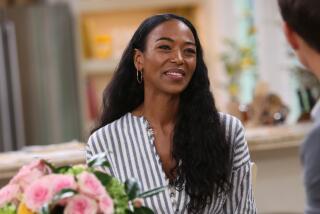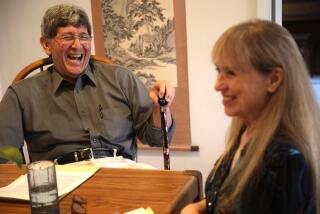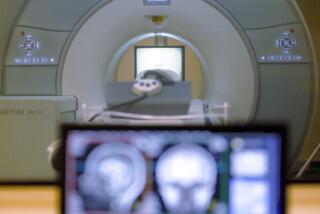‘Miracle’ Saves 3-Year-Old Girl Stricken With Eye Cancer
CARLSBAD, N.M. — Two-year-old Krista Cordova woke up in July 1994 with a red and swollen left eye.
“Pink eye,” her mother, Angie, told her father, Mark. Treatment would have to wait; it was Sunday and the clinic wasn’t open.
Krista was irritable and cried throughout the day, but the problem didn’t seem to warrant the emergency room.
The Cordovas soon learned that the way Krista’s eye looked was only a hint of the real problem.
A Carlsbad doctor pointed a light into the eye, and when the pupil did not dilate, advised the parents to take Krista to a specialist as soon as possible.
What ophthalmologist Dr. Michael Lim found peering into Krista’s eyes confirmed his worst suspicion--cancer. He sent the Cordovas to El Paso, the closest city with pediatric ophthalmologists.
On their third wedding anniversary, the couple listened as three different specialists verified Lim’s diagnosis: retinal blastoma, cancer of the eye.
They said the malignant tumor probably had grown since Krista’s birth. And there were more in her other eye.
Two days later, the Cordovas flew to Texas Children’s Hospital in Houston, renowned for cancer research on children.
Dr. Milton Boniuk, Krista’s ophthalmologist, told the Cordovas that her type of cancer was extremely rare. He would have to remove her left eye immediately.
Four tumors were found in the right eye. Radiation might not work, and with or without complete removal of the remaining tumors, Krista could eventually die.
There was little hope of curing the cancer.
But they decided to try.
The eye was removed and the Cordovas stayed in Houston for eight weeks. For people who knew nothing about cancer only days before, Mark and Angie Cordova soon became experts.
A week after surgery, a central line was put into Krista’s chest, allowing quick anesthesia for daily radiation treatments. Semi-permanent lines were marked on her face for precise radiation direction.
The third week, Krista began radiation treatments.
For five weeks, lasers were beamed onto the cancer, burning off the tumors’ blood supply and shrinking the masses. In the recovery room, Krista ran around as if she’d just awakened from a nap.
Then the Cordovas went home to Carlsbad and spent time with their family.
As everyone fawned over Krista, her mother thought, “Boy, you really need your family.”
It was harder outside their home. Children pointed and adults stared at the clear eye that temporarily replaced Krista’s real one, magnifying the tissues behind it.
Friends asked, “What can we do?”
The couple’s standard reply, with tears in their eyes: “Pray.”
Krista soon was fitted with a glass eye, colored to match her right one.
The family continued to go to Houston for radiation treatments.
In December 1994, on the fourth trip for treatments, Boniuk said the tumors were shrinking. Three had disappeared--but the big one refused to die.
And Boniuk found little white seeds ready to bud into tumors.
He wanted to try chemotherapy, but Angie Cordova had heard that it had never killed a tumor in such a remote and small area as the eye.
Boniuk agreed. But he wanted to try.
Two weeks later, oncologist Dr. Robert Mahoney explained that the chemo might never reach Krista’s eye. Fluids used in chemotherapy are poison, so even if they reached the tumors, other organs might be damaged. Her hair would fall out. She would vomit; she might have seizures, lockjaw.
Mahoney said he didn’t want to try it.
“It’s up to you,” Mahoney told the Cordovas.
Cordova heard the doctor out, then told him: “I don’t know if you’re a Christian or if you believe in God, but we do. A lot of prayer is going to bring us back here with reports that say ‘miracle’ on them.”
Looking at the bald children in the Houston hospital, Angie Cordova said to herself, “OK, it’s our turn to go through this.”
The day after Christmas in 1994, when the family had returned to Carlsbad, Krista’s thick hair started falling out in clumps. Angie Cordova called her husband at work, crying. “You come home, now,” she said.
His mother came instead. Again, Angie Cordova thought, “It’s good to be near family.”
“Krista,” she told her little girl, “your hair is going to fall out from your treatments.”
“OK,” Krista said.
Two weeks later, she was bald.
Every month the Cordovas traveled to Houston for the weeklong process. Poison flowed into Krista’s veins in an attempt to kill the budding tumors and the stubborn large one.
Krista also was anesthetized and her eye examined during the visits.
“It’s working little by little,” her parents were told in hallway visits with Boniuk.
In June, Boniuk walked up to Angie Cordova as he had many times before.
“I don’t see anything in there,” he told her.
The stubborn tumor had disappeared.
Tears poured down her face as she pumped the doctor’s hand. She ran into the waiting room and, with tears streaking her cheeks, told the people there over and over, “My baby doesn’t have cancer! My baby doesn’t have cancer! I don’t know what to do with myself!”
In the consultation room, she sat across from Mahoney, who was smiling from ear to ear.
“What should I put on here?” he asked with a mischievous grin, holding Krista’s thick file. “Should I write what your husband told me?”
Not waiting for an answer, he jotted in ink across Krista’s permanent record: “Miracle.”
With cancer, the word “cure” is not used until five years after tumors disappear. But the Cordovas believe that their daughter is out of troubled waters.
They have traveled to Houston several times for follow-up examinations. They have seen other children with retinal blastoma receiving the treatment pioneered with Krista.
On their November visit, Boniuk told them, “See you in three months.” The Cordovas looked at each other, stunned. This was a landmark.
Today, 3 1/2-year-old Krista’s hair is sprouting. The family now lives in Loving, N.M., and her parents focus on her starting school.
Soon, they’ll have to let her face the world independently. They won’t be there to remind her to not play rough and to wear protective glasses.
“People say, ‘I couldn’t do it,’ ” Angie Cordova said. “And I tell them, ‘Yes, you can. If it’s your child, you will go from here to there for them.’ ”
More to Read
Sign up for Essential California
The most important California stories and recommendations in your inbox every morning.
You may occasionally receive promotional content from the Los Angeles Times.










